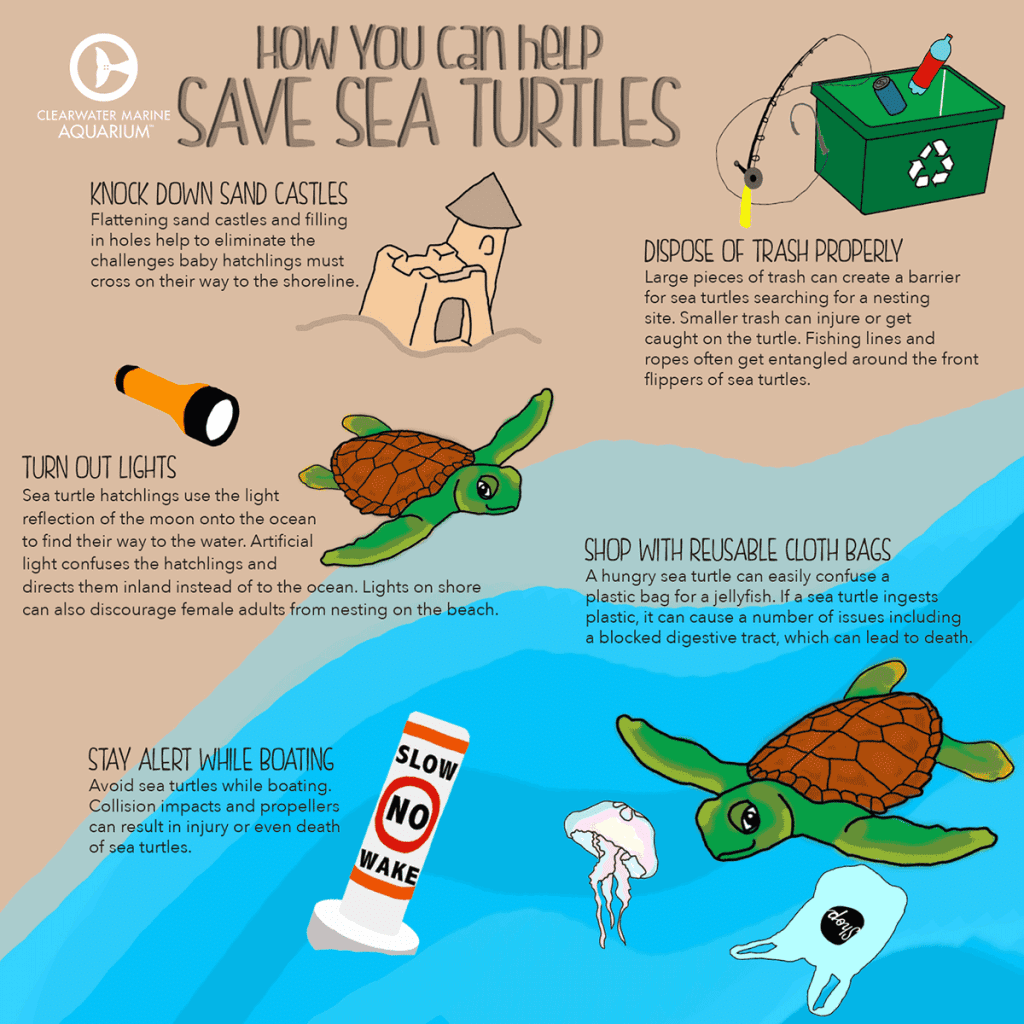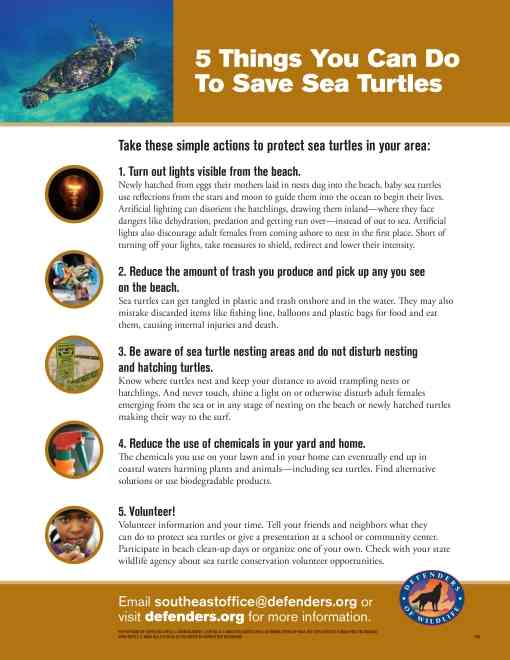To help sea turtles, we can reduce plastic pollution and support conservation efforts. Sea turtles are majestic creatures that have lived on our planet for millions of years.
Unfortunately, human activities have put them at risk of extinction. One of the biggest threats to sea turtles is plastic pollution. Every year, millions of tons of plastic end up in the ocean, where sea turtles mistake it for food or get entangled in it, causing injury or death.
To help sea turtles, we can reduce plastic waste by using reusable bags, bottles, and containers, and properly disposing of our trash. Additionally, we can support conservation efforts by donating to organizations that work to protect sea turtles and their habitats, volunteering for beach cleanups, and spreading awareness about the importance of these amazing creatures. By taking action, we can make a positive impact on the survival of sea turtles and the health of our oceans.

Credit: madeirabeachfl.gov
Threats To Sea Turtles
Sea turtles face various threats that put their survival at risk. Understanding these threats is crucial in taking action to protect these magnificent creatures.
Pollution
Pollution, especially plastic waste, poses a significant threat to sea turtles. Ingesting plastic can lead to digestive issues and even death for these marine animals.
Climate Change
Climate change is causing rising sea levels and warmer ocean temperatures, which impact the nesting habitats of sea turtles. Shifts in temperature can disrupt their reproductive cycles.
Habitat Destruction
The destruction of nesting beaches due to coastal development and human activities is a major threat to sea turtles. Loss of nesting sites reduces their chances of successful reproduction.
Conservation Efforts
Conservation efforts are crucial to protecting sea turtles and ensuring their survival for future generations. Various initiatives and strategies have been implemented to safeguard these magnificent creatures and their habitats.
Protected Areas
Establishing protected areas is a vital aspect of sea turtle conservation. These designated zones provide a safe haven for sea turtles to feed, breed, and nest without disturbance from human activities. By safeguarding these areas, we can help maintain healthy populations and ensure the continued existence of these species.
Nesting Beach Management
Effective management of nesting beaches is essential in protecting sea turtle populations. This includes monitoring and protecting nesting sites, controlling beachfront lighting to prevent disorientation of hatchlings, and minimizing human interference during the nesting season. Through these efforts, we can enhance the survival rates of hatchlings and contribute to the overall conservation of sea turtles.
Fishing Gear Regulations
Implementing fishing gear regulations is crucial in mitigating the impact of commercial fishing on sea turtles. By mandating the use of turtle excluder devices (TEDs) and implementing fishing gear modifications, we can reduce accidental captures and mortalities of sea turtles. These regulations play a pivotal role in promoting sustainable fishing practices while safeguarding sea turtle populations.
Community Involvement
Engaging in community efforts is vital to protect sea turtles. By participating in educational programs, volunteering, and beach clean-ups, we can make a difference in their conservation.
Educational Programs
- Learn about sea turtles’ habitats and behaviors.
- Understand the threats they face from human activities.
- Gain knowledge on how to promote sea turtle conservation.
Volunteer Opportunities
- Join local organizations dedicated to sea turtle protection.
- Assist in nesting surveys and hatchling releases.
- Participate in rescue and rehabilitation efforts for injured turtles.
Beach Clean-ups
- Organize or join community-led beach clean-up events.
- Remove plastics and debris that pose threats to sea turtles.
- Contribute to creating safer nesting environments for turtles.
Research And Monitoring
Research and monitoring are crucial components in the conservation efforts for sea turtles. By studying their populations, tracking their movements, and conducting nesting surveys, we can gather valuable data to better understand and protect these magnificent creatures.
Population Studies
Population studies provide vital insights into the health and trends of sea turtle populations. Researchers analyze factors such as nesting numbers, genetic diversity, and growth rates to assess the overall status of these species. This information helps in formulating effective conservation strategies and identifying areas that require immediate attention.
Tracking Technologies
Tracking technologies play a significant role in monitoring the migratory patterns and behavior of sea turtles. Utilizing satellite tags and GPS devices, scientists can monitor their movements, foraging grounds, and nesting sites. This technology enables us to identify critical habitats and migration corridors, contributing to the development of protected areas and conservation measures.
Nesting Surveys
Nesting surveys involve meticulous monitoring of nesting beaches to document the frequency and locations of sea turtle nests. By recording data on nesting activities and the success rates of hatchlings, conservationists gain valuable insights into the reproductive success of these species. This information guides efforts to safeguard nesting habitats and mitigate threats to nesting females and their offspring.
Advocacy And Policy
Advocacy and policy play a crucial role in the protection of sea turtles. By lobbying for legal protections, campaigning for sustainable practices, and forming partnerships with governments, we can make a significant impact in ensuring the survival of these majestic creatures.
Lobbying For Legal Protections
Lobbying for legal protections involves advocating for the implementation and enforcement of laws that safeguard sea turtles and their habitats. This may include pushing for the establishment of marine reserves, stricter regulations on fishing practices, and penalties for the illegal trade of sea turtle products.
Campaigning For Sustainable Practices
Campaigning for sustainable practices entails raising awareness about the importance of conservation and promoting eco-friendly alternatives. This can involve initiatives to reduce plastic pollution, support for sustainable fishing methods, and encouraging responsible tourism that minimizes disturbances to nesting sites.
Partnerships With Governments
Forming partnerships with governments allows for collaboration on conservation efforts and the development of policies that prioritize the protection of sea turtles. This can involve engaging in dialogue with policymakers, providing scientific expertise, and advocating for the integration of sea turtle conservation into national and international agendas.
Rescue And Rehabilitation
When it comes to helping sea turtles, one crucial aspect is their rescue and rehabilitation. Rescue and rehabilitation efforts play a vital role in protecting and preserving these majestic creatures.
Rescue Operations
Rescue operations involve the timely response to distressed sea turtles in need of assistance. Trained professionals and volunteers work together to rescue turtles entangled in fishing gear, injured due to boat strikes, or affected by pollution.
Rehabilitation Centers
Rehabilitation centers provide a safe haven for injured or sick sea turtles to recover and receive necessary medical care. These facilities play a key role in the recovery process, ensuring that turtles are given the best chance to return to their natural habitat.
Release Programs
Release programs are essential for returning rehabilitated sea turtles back to the wild. Before release, turtles undergo thorough health assessments to ensure they are strong and healthy enough to survive in their natural environment.
Public Awareness
Public awareness plays a crucial role in the conservation of sea turtles. By educating and engaging the public, we can foster a greater understanding of the issues facing sea turtles and inspire action to protect these magnificent creatures. There are several effective methods to raise public awareness, including:
Social Media Campaigns
Social media platforms provide a powerful tool for spreading awareness about sea turtle conservation. Organizations and individuals can use platforms like Facebook, Instagram, and Twitter to share information, success stories, and calls to action. Engaging content, such as captivating images and informative videos, can reach a wide audience and inspire people to get involved in protecting sea turtles.
Documentaries And Films
Documentaries and films have the potential to reach a global audience and shine a spotlight on the challenges facing sea turtles. By showcasing the beauty of these creatures and highlighting the threats they face, filmmakers can effectively convey the urgency of conservation efforts. Collaborating with filmmakers to produce compelling documentaries can captivate viewers and motivate them to take action to protect sea turtles.
Celebrity Endorsements
Celebrities have a significant influence on public opinion and behavior. By leveraging their platform, celebrities can raise awareness about sea turtle conservation and inspire their followers to support related initiatives. Celebrity endorsements through social media posts, public appearances, and endorsements can significantly amplify the message of sea turtle conservation, reaching a broad audience and igniting passion for the cause.

Credit: defenders.org
Global Collaboration
Global Collaboration: Working together on a worldwide scale is crucial for the preservation of sea turtles.
International Agreements
International agreements like the Convention on Migratory Species provide a framework for countries to protect sea turtles.
Cross-border Initiatives
Cross-border initiatives involve multiple nations joining forces to safeguard sea turtle habitats and migration routes.
Research Exchanges
Research exchanges enable scientists from different countries to share knowledge for the benefit of sea turtle conservation.

Credit: www.fisheries.noaa.gov
Conclusion
We can all play a part in helping sea turtles thrive. By reducing plastic usage, supporting conservation efforts, and spreading awareness, we can make a positive impact on their survival. Every small action counts, and together, we can ensure a brighter future for these magnificent creatures.
Let’s work together to protect and preserve our precious sea turtles.






Leave a Reply